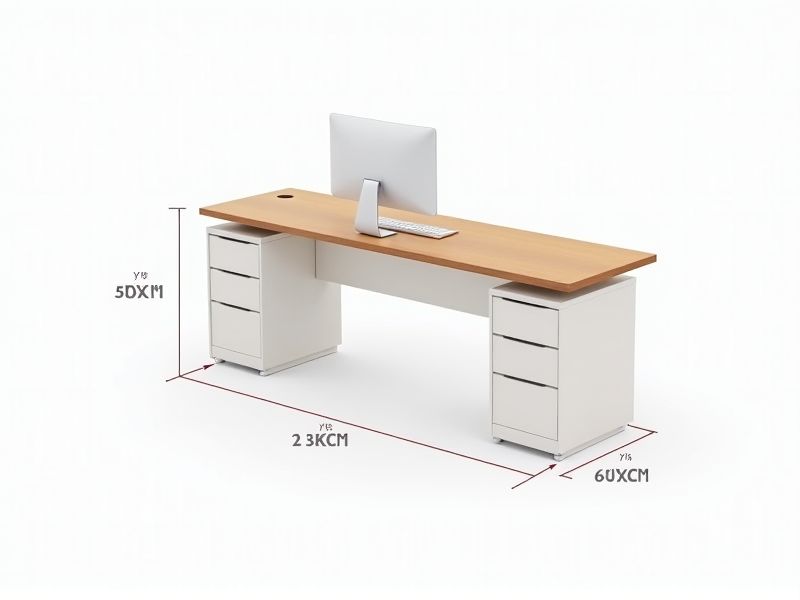
When setting up a workstation, it's important to consider standard dimensions to ensure comfort and productivity. Typically, a desk height of about 28-30 inches (71-76 cm) from the floor to the desktop works well for most adults, allowing for relaxed positioning of the arms and wrists. The recommended depth for a desk is at least 24 inches (61 cm) to accommodate a keyboard, monitor, and some workspace, while a standard width is around 47-60 inches (120-152 cm) to provide ample room for equipment and supplies. Adjusting your chair so your feet are flat on the floor and your elbows form a 90-degree angle can further enhance ergonomic benefits.
Desk Height
The standard desk height for a workstation typically ranges between 28 to 30 inches, ensuring optimal ergonomics for most individuals. Adjustable desks, which can vary in height from 24 to 50 inches, allow you to customize the setup for seated or standing positions, promoting healthier work habits. Maintaining your monitor at eye level is crucial; ideally, the top of the screen should be 2 to 3 inches above your seated eye line. Proper desk height contributes significantly to reducing the risk of musculoskeletal disorders, enhancing productivity by providing a more comfortable working environment.
Desk Width
A standard workstation typically requires a desk width of at least 60 inches (152 cm) to accommodate monitors, paperwork, and other essential tools without clutter. This width allows for a more organized workspace, enhancing productivity and comfort, especially in dual-monitor setups. Ergonomically, a desk width that suits your height can promote better posture, reducing strain while working for extended periods. Ensuring adequate desk space not only supports equipment placement but also fosters overall efficiency in daily tasks.
Desk Depth
Desk depth in a workstation is critical for ensuring comfort and efficiency during work tasks. An ideal desk depth typically ranges from 24 to 30 inches, allowing adequate space for monitor placement while preventing eye strain. Maintaining a proper distance of 20 to 30 inches between your eyes and the screen can significantly enhance productivity. Choosing a desk with adjustable depth options can also accommodate various tasks and equipment, ultimately improving your overall workstation ergonomics.
Chair Height
An ergonomic workstation chair height should ideally be adjustable between 16 to 21 inches from the floor, accommodating a range of body types for optimal comfort. Your feet should rest flat on the ground, ensuring that your knees are at a 90-degree angle while sitting. The chair's height directly impacts your posture, influencing spinal alignment and reducing the risk of musculoskeletal disorders. Proper chair height can enhance productivity by allowing you to maintain focus without physical discomfort during extended work hours.
Legroom Clearance
A proper workstation design emphasizes a minimum legroom clearance of 24 inches to ensure comfort and movement during prolonged use. Ergonomic guidelines suggest that the height of the under-desk area should allow for adequate space, accommodating users who may be seated or using mobility aids. Ensuring that your workspace allows for unobstructed leg movement can significantly reduce strain and enhance overall productivity. Research indicates that maintaining optimal legroom can lead to a 15% increase in overall comfort and focus during work tasks.
Monitor Height
An optimal workstation should have the monitor height positioned at eye level, typically between 20 to 30 inches away from your eyes. The top of the screen should align with your eyes or slightly below, reducing neck strain and promoting a neutral posture. This setup aids in minimizing distractions and enhancing productivity, with studies indicating that proper monitor height can improve focus levels by up to 15%. Adjusting your monitor height can lead to more comfortable viewing angles, contributing to better overall workplace well-being.
Monitor Distance
The optimal monitor distance for workstation ergonomics is generally between 20 to 30 inches from your eyes, aligning with the screen's height at or just below eye level. This positioning reduces eye strain and enhances comfort during prolonged use, promoting a healthy posture. You should also consider adjusting the screen's brightness and contrast to create a balanced visual experience, minimizing glare. For multi-monitor setups, ensure the primary display is directly in front of you, while secondary displays are positioned within your peripheral vision, facilitating efficient productivity.
Keyboard Placement
Proper keyboard placement is crucial for enhancing your workstation ergonomics and productivity. Ideally, the keyboard should be positioned at or just below elbow height, allowing your arms to rest at a 90-degree angle or slightly acute. The distance from your eyes to the monitor should be approximately 20 to 30 inches, ensuring you maintain a comfortable viewing distance while keeping your wrists straight. By optimizing these dimensions, you can minimize strain and improve your overall comfort during long hours of typing.
Armrest Positioning
Proper armrest positioning is crucial for enhancing workstation ergonomics, significantly impacting your comfort and productivity. Ideally, the height of armrests should align with your elbows bent at approximately 90 degrees, allowing your arms to rest comfortably without shoulder tension. In a typical office setting, getting the armrest height between 7 to 10 inches above the seat height can foster a more relaxed posture. Regularly adjusting armrests ensures they support your forearms effectively while you type, leading to reduced strain and increased focus during prolonged work sessions.
Footrest Requirement
A footrest is essential for promoting ergonomic posture in a workstation, as it allows your feet to maintain proper alignment while seated. Research indicates that using a footrest can reduce leg discomfort by up to 30%, especially for individuals who sit for extended periods. The ideal footrest height should be adjustable, generally ranging from 3 to 6 inches, accommodating different user needs. Ensuring your feet are supported can enhance circulation and promote overall productivity during long working hours.
